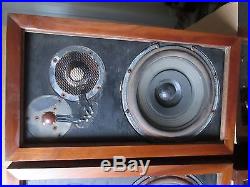
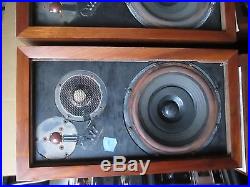


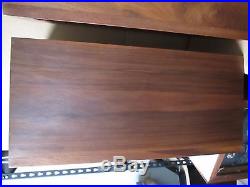
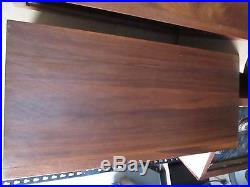
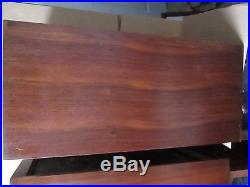


Acoustic Research AR3 speakers in excellent condition. One grill had a couple breaks in the frame. I hot-glued the breaks. A few small chips I filled and touched up. They”re barely noticeable. I lightly sanded and oiled the wood veneer to restore the grain, and overall they look excellent. I’m going to put one or two more coats of oil on them. Acoustic Research AR-3 History. To knowledgeable audiophiles and historians, the Acoustic Research AR-3 needs no detailed introduction. From its commercial introduction in early 1959 throughout the next decade, it was considered to be one the finest and most accurate loudspeakers commercially available at any price. At this point, the AR-3 has become a high-fidelity icon, arguably the most famous loudspeaker in history. The AR-3 was developed at Acoustic Research by founder and researcher Edgar Villchur. Its design was based extensively on scientific research and industry-standard objective-measurement techniques with published performance, pioneered by Acoustic Research. ARs standardized-measurement techniques, using their anechoic chambers and reverberant-test chambers, were easily repeatable by other testing labs, and AR led the entire high-fidelity industry in publishing the results of this testing. This was somewhat controversial at a time when most loudspeaker companies more or less exclusively used listening tests to develop loudspeakers, and generally kept their internal testing results proprietary. The result of ARs objective design philosophy was a no-nonsense product capable of high acoustic accuracy. In fact, the only subjective validations of the AR-3s accuracy were the many public live-vs. Recorded concerts and demonstrations conducted by AR in the early 1960s, and these, too, set industry standards that have not been surpassed to this very day. The AR-3 was the first commercial loudspeaker to use direct-radiator, hemispherical dome midrange and tweeter drivers. These dome drivers, as well as the acoustic-suspension woofer system (first used on the 1954 AR-1), were covered under AR patents. The acoustic-suspension woofer and dome tweeter are commonplace and virtually universal in the speaker industry today. As a lasting tribute to this remarkable piece of history, an AR-3 is on permanent display in The Natural Museum of American History of the Smithsonian Institution. When the AR-3 was introduced, it had no peer in terms of low-frequency extension, low distortion and extended, high-frequency acoustic-power response. It is still considered to be one of the finest loudspeakers ever designed. Its place in history was made secure during the early 1960s when Acoustic Research conducted dozens of public, live-vs. These bold, live concerts compared pre-recorded music on AR-3s to the Fine Arts Quartet, classical-guitarist Gustavo Lopez and a restored 1910 Seeburg Nickelodeon. In virtually every demonstration, listeners were unable to detect the switchovers between the live musicians and the reproducing AR-3 loudspeakers. It is a remarkable testament to both the AR-3 accuracy and Edgar Villchur’s understanding of the proper way to record and reproduce live musicians and instruments. Because of the AR-3s remarkable critical acclaim and ground-breaking innovation during this period, it quickly became a classic loudspeaker design, and has become a highly-collectible audio artifact. Audio legend Julian Hirsch said of the AR-3 in his 1960 High Fidelity magazine review: The sounds produced by this speaker are probably more true to the original program than those of any other commercially manufactured speaker system we have heard. The leading consumer-testing organization stated that the AR-3 had the deepest bass ever measured in their laboratories. AR-3 Performance and Physical Description. The AR-3 is a 3-way, full-range, 4-ohm acoustic-suspension loudspeakertechnically a bookshelf speaker for very sturdy bookshelveswhich includes the now-famous AR 12-inch acoustic-suspension woofer and a dome midrange and tweeter. The enclosure size is exactly optimal for the 43 Hz resonance frequency, and the restoring force ratio is approximately 80% acoustic and 20% mechanical, far greater than the bulk of current consumer loudspeakers using the a/s design. This is one reason why the AR-3 has much lower harmonic distortion than nearly any current-design loudspeaker in a comparable size. This woofer has a large 9.6 lb Alnico-5 magnet assembly, cast-aluminum frame and a long-throw, 2-inch heavy copper voice coil with a linear excursion of 5/8-inch and a maximum excursion of nearly 1 inch. The midrange driver has a 2-inch phenolic-dome (hemispherical) diaphragm with a self-supporting, 2-inch aluminum voice coil and a 9.2 lb. The super tweeter uses a 1-3/8-inch phenolic-dome diaphragm of the same design with a 3.3 lb. Alnico-5 magnet assembly, and the drivers have LC crossover frequencies of 1000 Hz and 7,500 Hz. High-frequency dispersion, measured 45° off-axis in any direction is -3 dB at 10 kHz and -7 dB at 15 kHz. The dome midrange and super tweeter have very wide dispersion in any direction when measured off-axis, and the system has exceptionally wide and uniform acoustic-power response. Uniform polar response measurement of this system was greater than 90° at 8 kHz in any direction, even with the grill molding in place. Harmonic distortion is less than 1.5% above 35 Hz and 3.2% at 30 Hz, with >10 watts input. At 20 Hz with over 20 watts input, distortion is less than 8%. Few, if any conventional speakers made today can surpass, let alone equal, this level of quality in low-frequency performance. Because of its very low harmonic distortion, the AR-3 is capable of strong, fundamental bass energy down to 30 Hz, with usable but diminished response to below 20 Hz. The speaker is approximately 0.5% efficient, meaning that an amplifier capable of at least 25-50 watts-per-channel is the minimum suitable power. Dimensions: 25 x 14 x 11 1/2. In the unlikely event that there is some problem with the item, please do the courtesy of contacting me before you file a complaint. I package very well and rarely have anything damaged. These will be well packaged with 1/2 inch of foam on the top and 3 inches of foam bottom and inch all around inside cardboard. The item “Acoustic Research AR3 speakers in excellent condition” is in sale since Friday, April 22, 2016. This item is in the category “Consumer Electronics\Vintage Electronics\Vintage Audio & Video\Vintage Speakers”. The seller is “audiojoe1212″ and is located in Henrico, Virginia. This item can be shipped to United States, to Canada, to United Kingdom, DK, RO, SK, BG, CZ, FI, HU, LV, LT, MT, EE, to Australia, GR, PT, CY, SI, to Japan, to China, SE, KR, ID, to Taiwan, ZA, TH, to Belgium, to France, to Hong Kong, to Ireland, to Netherlands, PL, to Spain, to Italy, to Germany, to Austria, IL, to Mexico, to New Zealand, SG, to Switzerland, NO, SA, UA, AE, QA, KW, BH, HR, MY, TR, BR, CO, PA, JM.
- Brand: Acoustic Research
- Model: AR3
- Country/Region of Manufacture: United States
